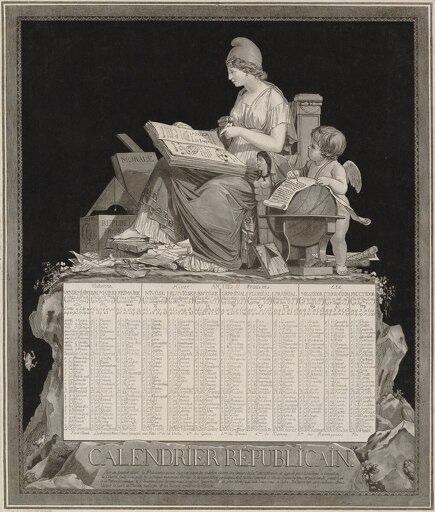An alternate calendar system briefly used by republican France. It had 360 days per year with 5 or 6 “intercalary” or leap days between years. It had 12 months of 30 days, which were comprised by 3 weeks of 10 days. Every day of the year had a unique name: a common plant, animal, mineral, or tool/equipment (ie January 31 was “Broccoli” and May 4 was “Silkworm”).
YSK because it’s an interesting alternative to the Gregorian calendar and the occasionally-proposed 13 month calendar.
Though it did have some problems such as starting in late September (very unusual for a calendar) and not having a robust leap-year system.
The Common Era, commemorating the birth of Jesus Christ, was abolished and replaced with l’ère républicaine, the Republican Era, signifying the “age of reason” overcoming superstition, as part of the campaign of dechristianisation.
So cool.
Shame they then gave up reason and gave power to a self proclaimed emperor who went on murderous rampage across Europe.
I’ll never understand how the beautiful Paris Commune led next to fucking Napoleon
Disenfranchised ruling class commits to counter-revolution. Repeat.
But for that specifically, it is conveniently called the Thermidorian Reaction, using this calendar’s terminology.
They also had metric clocks.
But in any case, I’m more intrigued by the idea of the calendar with thirteen 28-day months. Too many religions are invested in the question of what day of the week it is to move away from a seven-day week.
Alternatively 8 months of 5 weeks of 9 days with 5 days spread between them. 3 days off each week. Each month begins on a solstice, equinox, or halfway between them.
We can go as crazy as we’d like
Yes, they also decided to change the time to decimal time.
The day was divided into 10 hours, each hour was 100 minutes …
13! A prime number indivisible into anything. Ugh!
13! is definitely not a prime number, but it’s too large to be useful in this context (I know, I know, you didn’t actually MEAN 13-factorial, but I’ve studied enough maths that I couldn’t help it).
I’ve seen people object to a 13 month calendar based solely on the idea that you can’t divide the year into quarters. But it’s actually really easy to remember. A quarter is 13 weeks, or 3 months and 1 week. So Q1 ends a week after month three, Q2 ends 2 weeks after month six, Q3 ends 3 weeks after month nine, and q4 ends after month 13 aka the end of the year. And since the calendar doesn’t change, you don’t even need to remember it, just mark the quarter ends once and you’re done forever.
Just compare that to the unnecessary complexity of the Gregorian calendar and the effort it takes to remember basically anything that changes from year to year, or what day of the week any given date or holiday falls on, or even just which months have 30 days and which have 31.
Fine! Four months of thirteen weeks, and no more complaining!

Holy crap this is what I wanted. at least four of the intercalary days should be the solstice and equinoxes. and I wanted the weeks to be 5 weeks of 6 days per month with every month starting and ending on the same day. I would be tempted for the fifth and sixth intercalary to be after the winder solstice and call the fifth new years and the sixth one leap day or something. I figure thats sorta the main holiday time anyway.
I really like the idea of 10 days because of where weeks come from. In many languages, the names of days trace back to major celestial bodies (Sun, Moon, and the five planets). This is very obvious in English with Sunday (Sun), Monday (Moon), and Saturday (Saturn) but less obvious with other days because the names were converted into Germanic gods (Thursday = Thor’s day, though the planet should be Jupiter).
Well now that we know there’s two more planets: Uranus and Neptune, and the Earth is also a planet… it would kinda make sense to add 3 more days to the week for Uranus, Neptune, and Earth.
The actual French republican calendar just uses numbered days ie primidi, duodi, tridi similar to Chinese and Portuguese but imo that’s so boring.
yeah its just kinda long.
Yeah unless it comes with 5-day weekends 😢
In the revolutionary context, the extra days were all piled into the end of the year. Kind of a special short month, or more realistically a set of days not in a month. But yeah, leap days were added there when necessary.
Twelve months of five weeks of six days plus five or six days at the end for Christmas and New Years would absolutely rule. As long as weeks became 4+2 and not 5+1, anyway. I say we drop Thursdays and just keep the rest of the day names, they’re fine.
Best we can do is 996 with the new 6-day weeks.
I like T/W/F more than T/Th/F but I still rather Thursday over Wendedsday
I think it would be fair to highlight that this was revolutionary France’ brainchild. It is a republic today as well but they’ve gone back and forth on that one a bit in the last two centuries.
12 months of 30 days
January 31
You can only pick one of these.
They did not have a 31st day and neither did they have a January. Rather, the day that we call January 31 was the 12th day of Pluviôse and also had its own name “Broccoli”
Starting the year in January sucks. Ancient civilizations had it right with a start of the year at the Spring equinox. The original design by Sylvain Marechal, right before the Revolution started, did start in March…
That’s completely irrelevant to my point, which was that in a calendar of 12 30-day months you can’t have a 31st day of any month.
As I recall, a major reason it didn’t take off was very simple: the new “Sunday” only came every 10 days instead of 7!
The best bit about it was definitely the evocative month names.
Thermidor > July ×10
School year starts around September so that’s kind of nice but what did it in, or so I have heard, was the 10 day workweek, just too long.








